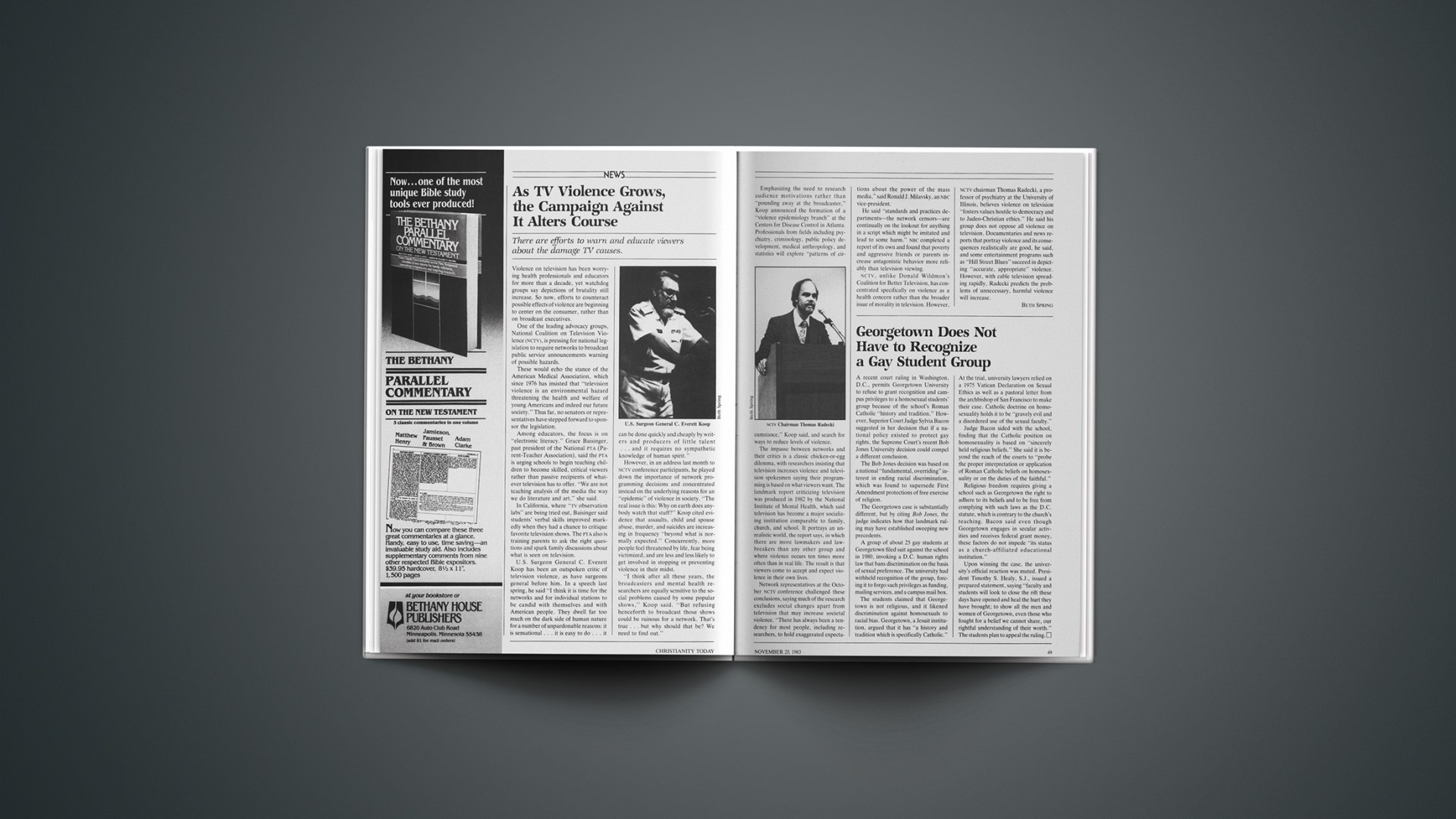There are efforts to warn and educate viewers about the damage TV causes.
Violence on television has been worrying health professionals and educators for more than a decade, yet watchdog groups say depictions of brutality still increase. So now, efforts to counteract possible effects of violence are beginning to center on the consumer, rather than on broadcast executives.
One of the leading advocacy groups. National Coalition on Television Violence (NCTV), is pressing for national legislation to require networks to broadcast public service announcements warning of possible hazards.
These would echo the stance of the American Medical Association, which since 1976 has insisted that “television violence is an environmental hazard threatening the health and welfare of young Americans and indeed our future society.” Thus far, no senators or representatives have stepped forward to sponsor the legislation.
Among educators, the focus is on “electronic literacy.” Grace Baisinger, past president of the National PTA (Parent-Teacher Association), said the PTA is urging schools to begin teaching children to become skilled, critical viewers rather than passive recipients of whatever television has to offer. “We are not teaching analysis of the media the way we do literature and art,” she said.
In California, where “TV observation labs” are being tried out, Baisinger said students’ verbal skills improved markedly when they had a chance to critique favorite television shows. The PTA also is training parents to ask the right questions and spark family discussions about what is seen on television.
U.S. Surgeon General C. Everett Koop has been an outspoken critic of television violence, as have surgeons general before him. In a speech last spring, he said “I think it is time for the networks and for individual stations to be candid with themselves and with American people. They dwell far too much on the dark side of human nature for a number of unpardonable reasons: it is sensational … it is easy to do … it can be done quickly and cheaply by writers and producers of little talent … and it requires no sympathetic knowledge of human spirit.”
However, in an address last month to NCTV conference participants, he played down the importance of network programming decisions and concentrated instead on the underlying reasons for an “epidemic” of violence in society. “The real issue is this: Why on earth does anybody watch that stuff?” Koop cited evidence that assaults, child and spouse abuse, murder, and suicides are increasing in frequency “beyond what is normally expected.” Concurrently, more people feel threatened by life, fear being victimized, and are less and less likely to get involved in stopping or preventing violence in their midst.
“I think after all these years, the broadcasters and mental health researchers are equally sensitive to the social problems caused by some popular shows,” Koop said. “But refusing henceforth to broadcast those shows could be ruinous for a network. That’s true … but why should that be? We need to find out.”
Emphasizing the need to research audience motivations rather than “pounding away at the broadcaster,” Koop announced the formation of a “violence epidemiology branch” at the Centers for Disease Control in Atlanta. Professionals from fields including psychiatry, criminology, public policy development, medical anthropology, and statistics will explore “patterns of circumstance.” Koop said, and search for ways to reduce levels of violence.
The impasse between networks and their critics is a classic chicken-or-egg dilemma, with researchers insisting that television increases violence and television spokesmen saying their programming is based on what viewers want. The landmark report criticizing television was produced in 1982 by the National Institute of Mental Health, which said television has become a major socializing institution comparable to family, church, and school. It portrays an unrealistic world, the report says, in which there are more lawmakers and lawbreakers than any other group and where violence occurs ten times more often than in real life. The result is that viewers come to accept and expect violence in their own lives.
Network representatives at the October NCTV conference challenged these conclusions, saying much of the research excludes social changes apart from television that may increase societal violence. “There has always been a tendency for most people, including researchers, to hold exaggerated expectations about the power of the mass media,” said Ronald J. Milavsky, an NBC vice-president.
He said “standards and practices departments—the network censors—are continually on the lookout for anything in a script which might be imitated and lead to some harm.” NBC completed a report of its own and found that poverty and aggressive friends or parents increase antagonistic behavior more reliably than television viewing.
NCTV, unlike Donald Wildmon’s Coalition for Better Television, has concentrated specifically on violence as a health concern rather than the broader issue of morality in television. However, NCTV chairman Thomas Radecki, a professor of psychiatry at the University of Illinois, believes violence on television “fosters values hostile to democracy and to Judeo-Christian ethics.” He said his group does not oppose all violence on television. Documentaries and news reports that portray violence and its consequences realistically are good, he said, and some entertainment programs such as “Hill Street Blues” succeed in depicting “accurate, appropriate” violence. However, with cable television spreading rapidly. Radecki predicts the problems of unnecessary, harmful violence will increase.










